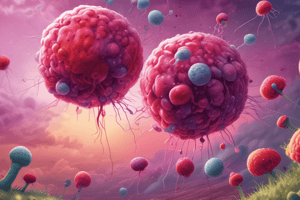Podcast
Questions and Answers
What role do antimicrobial peptides play in the immune response?
What role do antimicrobial peptides play in the immune response?
- They function only in the adaptive immune response.
- They directly attack microbes or impede their reproduction. (correct)
- They enhance the reproduction of pathogens.
- They act as receptors that recognize pathogens.
Which of the following are types of pattern-recognition receptors (PRRs)?
Which of the following are types of pattern-recognition receptors (PRRs)?
- Cytokine receptors and antibody receptors
- Toll-like receptors (TLRs) and C-type lectin receptors (CLRs) (correct)
- Complement receptors and membrane-bound receptors
- Neutrophil receptors and macrophage receptors
What distinguishes pathogen-associated molecular patterns (PAMPs) from damage-associated molecular patterns (DAMPs)?
What distinguishes pathogen-associated molecular patterns (PAMPs) from damage-associated molecular patterns (DAMPs)?
- PAMPs are associated with microbial pathogens, while DAMPs are associated with host cell damage. (correct)
- PAMPs are exclusively recognized by adaptive immunity.
- DAMPs are utilized only in the presence of specific pathogens.
- PAMPs are produced by host cells while DAMPs are not.
Which cells primarily express pattern-recognition receptors (PRRs)?
Which cells primarily express pattern-recognition receptors (PRRs)?
Which type of immune response do complements participate in?
Which type of immune response do complements participate in?
How do defensins, a type of antimicrobial peptide, function?
How do defensins, a type of antimicrobial peptide, function?
Why are pattern-recognition receptors also called primitive pattern recognition receptors?
Why are pattern-recognition receptors also called primitive pattern recognition receptors?
What is one of the functions of cytokines in the immune response?
What is one of the functions of cytokines in the immune response?
Which of the following is a function of pattern recognition receptors (PRRs)?
Which of the following is a function of pattern recognition receptors (PRRs)?
What type of receptors are Toll-like receptors (TLRs) primarily considered?
What type of receptors are Toll-like receptors (TLRs) primarily considered?
What do nucleotide-binding oligomerization domain-like receptors (NLRs) primarily recognize?
What do nucleotide-binding oligomerization domain-like receptors (NLRs) primarily recognize?
What structures do TLRs possess that are important for their function?
What structures do TLRs possess that are important for their function?
Which of the following receptors recognizes carbohydrate components?
Which of the following receptors recognizes carbohydrate components?
How many distinct TLRs are present in humans?
How many distinct TLRs are present in humans?
What is a characteristic feature of C-Type Lectin Receptors (CLRs)?
What is a characteristic feature of C-Type Lectin Receptors (CLRs)?
What structural feature do NLRs possess related to their functionality?
What structural feature do NLRs possess related to their functionality?
Flashcards are hidden until you start studying
Study Notes
Immune Responses and Soluble Molecules
- Soluble molecules play critical roles in both innate and adaptive immune responses.
Innate Immune Responses
- Cytokines: Include interleukins (IL) and interferons (IFN), signaling proteins that mediate immune responses.
- Antimicrobial Peptides:
- Target and eliminate microbes or inhibit their reproduction.
- Defensins are key examples, categorized into α-defensins and β-defensins, known for disrupting microbial membranes and inhibiting RNA, DNA, and protein synthesis.
- Primarily produced by neutrophils and epithelial cells.
- Complement System: Consists of proteins that enhance the ability of antibodies and phagocytic cells to clear microbes.
- Pattern-Recognition Receptors (PRRs):
- Detect unique antigens in microorganisms.
- Types include membrane-bound (e.g., Toll-like receptors, C-type lectin receptors) and cytoplasmic receptors (e.g., NOD-like receptors, RIG-I-like receptors).
Pattern-Recognition Receptors (PRRs)
- Function:
- Recognize non-self antigens (PAMPs and DAMPs).
- Activate immune responses, including opsonization, complement activation, phagocytosis, pro-inflammatory signaling, and apoptosis.
- PAMPs (Pathogen-Associated Molecular Patterns): Associated with microbial pathogens, these patterns signal the presence of potential threats.
- DAMPs (Damage-Associated Molecular Patterns): Released by host cells during damage, indicating cell stress or death.
Toll-Like Receptors (TLRs)
- A subset of PRRs, these proteins are essential for detecting microbial components post-barrier breach.
- Found on various immune and non-immune cells, including dendritic cells, macrophages, and epithelial cells.
- Recognize structurally conserved microbial molecules, leading to immune activation.
- Structure: Comprises exterior leucine-rich repeats (LRRs) and an interior TIR (Toll-IL-1 Receptor) domain.
- Types: Includes TLR1 to TLR13, with TLR11-13 not present in humans.
NOD-Like Receptors (NLRs)
- Cytoplasmic PRRs that detect both PAMPs and DAMPs.
- Participate in signal transduction and share structural similarities with TLRs.
- Comprise 23 family members, characterized by three domains: LRR, NACHT, and effector binding (EBD).
C-Type Lectin Receptors (CLRs)
- Surface receptors found on various immune cells: monocytes, macrophages, dendritic cells, etc.
- Recognize carbohydrate components from fungi, bacteria, viruses, parasites, and allergens.
- Major human CLRs include receptors for mannose, fucose, and glucans, facilitating immune signaling and phagocytosis.
Studying That Suits You
Use AI to generate personalized quizzes and flashcards to suit your learning preferences.




